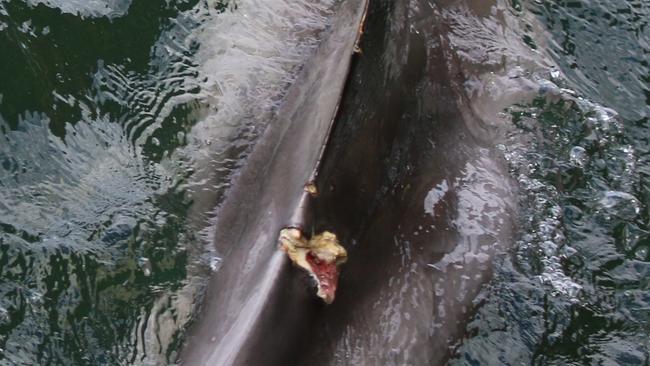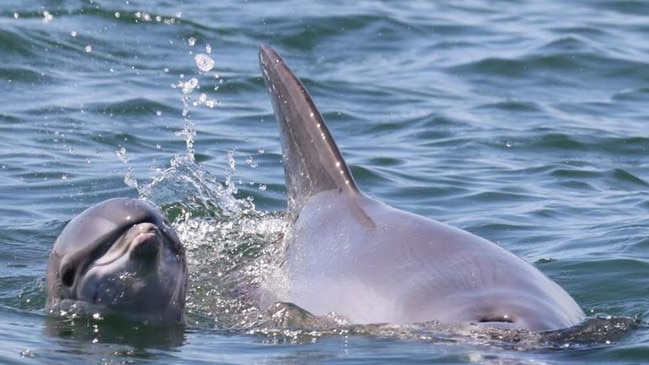Dolphin experts reject State Government’s finding into Port River dolphin’s death
DOLPHIN experts have rejected the State Government’s findings into the death of dolphin Oriana, who was found dead at Garden Island last month after suffering a horrific injury.
- Transport Minister Stephan Knoll open to changing speed limits in Adelaide Dolphin Sanctuary
- Dolphin expert ‘very optimistic’ about speed limit change
- Injured Port River dolphin Oriana dies
- Speeding boats are killing our Port River dolphins
DOLPHIN experts have rejected the State Government’s finding into the death of a dolphin in the Port River.
The interim findings of a post mortem into the death of Oriana — whose body was found at Garden Island last month — showed the cuts to her dorsal fin were “superficial in nature” and “not consistent with the typical appearance of a propeller injury”, an Environment and Water Department spokesman told the Portside Weekly.
He said the findings, which have not been publicly released, suggested that “Oriana was malnourished and found to be suffering from an underlying health condition including protozoal encephalitis and pox virus at the time of her death”.
But Adelaide dolphin expert Dr Mike Bossley — who has studied the Port River dolphins for the past 30 years — said based on the photographs of the injury he had seen, Oriana’s wound was more significant.
“The injury, while not life-threatening, did not look ‘superficial’ to me,” said Dr Bossley, who has been at previous post mortems conducted by the SA Museum but was not present at Oriana’s.
“I cannot envisage the wound being caused by another animal.”

Oriana’s post mortem was not conducted by the museum.
Instead, the State Government appointed Torrens Island-based Australian Marine Wildlife, Research and Rescue Organisation to carry out the investigation.
An SA Museum spokeswoman said the State Government had decided to have “a non-government body perform the necropsy” this time.
However, Natural Resources Adelaide and Mt Lofty Ranges manager Lisien Loan said it had chosen AMWRRO as it “was able to provide specialist expertise in forensic pathology as well as veterinary pathology, and therefore a greater degree of certainty in the findings”.
“This was an important consideration as it wasn’t immediately apparent whether Oriana’s death was the result of disease or injury, or both,” Ms Lisien said.
A full report has not been released yet and test results on heavy metal and environmental contaminants are still pending.
Due to the historical pollution in the Port River from industry and the use of Garden Island as a dump, the Port River dolphins often have heavy metals including lead and mercury in their systems.

Conservationist Marianna Boorman agreed with Dr Bossley’s assessment that Oriana’s wound was not “superficial” but concurred that she was ill when she suffered the injury — an observation she and other dolphin-watchers including Dr Bossley had made before her death.
“I spent a few hours monitoring Oriana closely from the land not long after she was first sighted with the injury,” Ms Boorman said.
“I agree that the wound is unlikely to be the cause of her death but in my opinion I would not classify the wound as ‘superficial’.
“My observations and photos show that this particular wound Oriana suffered appeared to cut right through her blubber.
“It is unclear what caused Oriana’s injury, however, we do know that young calves and sick or injured dolphins are at a greater risk of being hit by boats.”
Dolphin watcher Jenni Wyrsta found Oriana dead at Garden Island on September 6.
That same week another dolphin, Zoom, was found with non-life threatening gashes to his side and tail.
The Portside Weekly has been lobbying since April for a 10-knot speed limit to be introduced in the Port River sanctuary under its Protect Our Dolphins campaign.
Transport Minister Stephan Knoll recently met with Dr Bossley and Ms Boorman as well as stakeholders such as the Adelaide Speed Boat Club and Flinders Ports to discuss Dr Bossley’s speed limit proposal.
Mr Knoll has said he is open to changing the speed limits in certain sections of the sanctuary.
